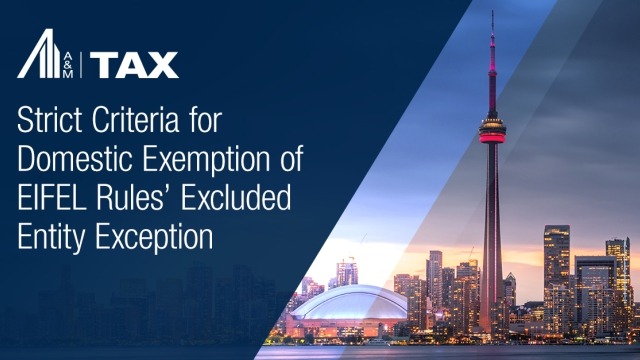Recent and Proposed Changes to Impact M&A Negotiations
2015-Issue 22—All of this has happened before, and this will all happen again. The scenario plays out universally: buyer meets target; buyer immediately falls in love with target; buyer and target are about to tie the knot, but as the courting process nears its culmination, the buyer identifies the target’s flaws and wants protection or a safeguard that the target’s issues will not affect their union. In any M&A transaction, there are inevitably tax issues that are identified by the buyer during the course of tax diligence. Even just the uncovering of those potential exposures likely has an impact on the dynamics of the deal as it moves forward. The process for dealing with those tax issues can vary from a purchase price adjustment, to a post-closing tax indemnity, to an amount of the purchase price held back in an escrow account — all of which depend on the relative negotiating positions of the parties.
Two recent announcements, Revenue Procedure 2015-13 and Proposed Regulation 100400-14 (which would amend Treasury Regulation Section 1.1502-76), facilitate the process for establishing a new beginning in the union between the buyer and target by providing a framework for dealing with tax issues that arise. Rev. Proc. 2015-13 allows the seller to clean up its tax position in the pre-closing period, while Proposed Reg. 100400-14 further clarifies the treatment of certain transaction costs between the pre- and post-closing periods.
This edition of the Tax Advisor Weekly describes a new process for mitigating certain tax liabilities due in the pre-closing period, and surveys the newly proposed rules that clarify the period in which certain transaction costs may be deducted.
Revenue Procedure 2015-13 — A New Beginning
In the course of negotiating a deal, potential unreserved tax liabilities may be identified by the buyer. Historically, the tax liability would loom over the target until it was eventually resolved or the statute of limitations lapsed. But the IRS has introduced a mechanism, albeit an elective one with limited application, to resolve tax liabilities in the pre-closing period related to changes in accounting methods. To show how this mechanism operates, the following examples are illustrative:
Example 1: Parent Corporation enters into an agreement to sell all of the stock of its wholly owned subsidiary, Target Corporation, to Buyer. Target Corporation is a calendar-year taxpayer. In the course of Buyer’s tax due diligence review of Target Corporation, Buyer discovers that Target Corporation improperly defers advance payments for services. Buyer requests that prior to its acquisition of Target Corporation, Target Corporation change its method of accounting for advance payments for services to a proper deferral method for 2014. Following the acquisition of Target Corporation by Buyer on February 28, 2015, Target Corporation files a Form 3115, Application for Change in Method of Accounting, with its 2014 tax return and applies for an automatic change to adopt an acceptable method of accounting for advance payments for services. Such automatic change results in an unfavorable adjustment to taxable income of $1 million pursuant to Section 481(a). Note that favorable adjustments (decreases to taxable income) are recognized in the year of change, while unfavorable adjustments (additions to taxable income) are spread over four tax years (note that a tax year is not always coextensive with a calendar year, and may be less than 12 months in length).
Historically, the change in method of accounting would be filed with the first post-acquisition tax return, with the result being that Buyer would suffer the effect of the unfavorable adjustment to taxable income over the following four tax years. Think of it as the curse that keeps on cursing.
However, under Rev. Proc. 2015-13, this treatment could change in a significant way. Effective for changes to accounting methods applied for after January 16, 2015, any additional taxable income that results from an acquisition-related change in method of accounting may now be taken into account entirely in the final pre-acquisition taxable year upon election by the buyer and seller. This treatment effectively takes the additional taxable income that a buyer would have to recognize in the periods following an acquisition and gives it back to the target in the pre-acquisition period where it rightfully belongs. Following the acquisition of Target Corporation in the example above, Buyer would ensure that Target Corporation’s final tax return for the pre-acquisition period would include the change in method of accounting, as well as the corresponding amount of additional taxable income.
Example 2: During 2014, Partnership, a calendar-year taxpayer consisting of Partners A, B, C and D, files a Form 3115, Application for Change in Method of Accounting, under the non-automatic change procedures for a change in method of accounting that results in an unfavorable adjustment to taxable income of $1.2 million pursuant to Section 481(a). Partnership receives consent for that change in method of accounting in a letter ruling on February 12, 2015. On February 26, 2015, Partner A, who already owns a 10 percent interest in Partnership, purchases all of Partner B’s 20 percent interest in Partnership. On April 15, 2015, Partnership files another Form 3115,Application for Change in Method of Accounting, under the automatic change procedures, resulting in an unfavorable adjustment of $1 million to taxable income for 2014.
In the partnership context, the partners must agree on the treatment of certain tax items. Prior to the issuance of Rev. Proc. 2015-13, the unfavorable adjustments of both $1.2 million and $1 million might have been made following the 2014 tax year and, therefore, would have been recognized over the following four tax years. Because of the issuance of Rev. Proc. 2015-13, Partnership now has the option to take the total amount of $2.2 million as a one-year adjustment for the 2014 tax year.
It should be noted that in order for Rev. Proc. 2015-13 to apply to a transaction, it must be an “eligible acquisition transaction,” which is a term of art meaning that it must be an acquisition of a stock ownership interest in a target by another party that either results in the acquisition of control of a target or causes a target’s taxable year to end; or it must be an acquisition of a target’s assets in the case of certain tax-deferred corporate reorganizations or liquidations. For all other targets (including partnerships and S corporations), an “eligible acquisition transaction” is an acquisition of an ownership interest in the target by another party that does not cause the target to cease to exist for U.S. federal income tax purposes.
In addition, Rev. Proc. 2015-13 is elective and subject to certain limitations. The “eligible acquisition transaction” must occur either in the tax year of the requested method of accounting change or in the subsequent tax year before the due date (including the extension) for filing the target’s federal income tax return for the year of the change. Once the election is made, it is irrevocable.
What’s Mine Is Mine, and What’s Yours Is Mine
Historically, transaction-related costs that arose in connection with an acquisition were often negotiated between the buyer and seller to determine which party would ultimately receive the benefit of the tax deduction. However, the IRS has attempted to curtail such negotiations by providing more clarity as to which period certain deductions may be taken in.
Typically, the buyer and seller are responsible for their own expenses, with each receiving a deduction for those items to the extent allowed or allowable under existing U.S. federal income tax rules. Transaction costs can be significant, and oftentimes generate substantial net operating losses in the short period that may be carried back to prior tax years, yielding cash tax refunds. Certain types of expenses, including accounting and legal costs, stock option deductions, and bonus payments to executives, are items that generally fall into the pre-acquisition period of an M&A transaction.
Under the current regulations, a target generally has two short taxable periods in the acquisition year: a pre-closing period that ends on the closing date of the transaction and a post-closing period as a member of a buyer’s consolidated group (to the extent it does in fact join a consolidated group):
- The “end of day” rule generally provides that for U.S. federal income tax purposes, a target corporation becomes a member of a buyer’s consolidated group or ceases to be a member of its former consolidated group at the end of the day on which its member status changes or the date of the transaction. This creates the pre-closing short period tax return.
- The “next day” rule is an exception to the end of day rule. It provides that if a tax item arising out of a transaction is properly allocable to the portion of the day following the transaction event that changed the target corporation’s member status, then it must treat the tax item as occurring at the beginning of the next day. Therefore, the item would be included on the post-closing tax period filing.
While the current regulations provide a framework to assist the buyer and seller in determining whether an item associated with a transaction is allocable to the proper period, the proposed regulations attempt to clarify the exact period in which the deduction should be reflected.
Proposed Reg. 100400-14 would clarify Treasury Regulation Section 1.1502-76 and, specifically, would impact the division of the tax benefits related to certain transaction expenses in an acquisition where a consolidated group acquires a C corporation target. The proposed regulations expand and clarify two key points:
- First, the proposed regulations clarify which “extraordinary items” are required to be allocated to the pre-closing period, thus removing the option for the buyer and seller to negotiate over whether their inclusion is in the pre- or post-closing periods. “Extraordinary items” under the current regulations include, for example, compensation-related deductions connected to the transaction, investment banker’s fees, bonus payments to executives, etc.
- Second, the proposed regulations would expand the definition of “extraordinary items” to make clear that deductions for fees paid to independent service providers in connection with the transaction are covered and, therefore, must be included in the pre-closing period.
In the context of a typical M&A transaction, perhaps Buyer plans to acquire Target Corporation, a member of a consolidated group. Target Corporation estimated its transaction expenses related to the acquisition to be approximately $500,000. In addition, Target Corporation must also cash out stock options to certain employees and shareholders upon the consummation of the acquisition. Each of these items would likely be discussed in negotiations between Buyer and the seller of Target Corporation. Under the clarifications provided by the proposed regulations, the compensation-related stock options would now be required to be included in the pre-close period as an end of day item. However, rather than treating the transaction-related “extraordinary items” as negotiable items that could possibly be allocated to the pre- or post-close periods, the proposed regulations essentially take away any electivity and state that if the item is allocable to the transaction and the result of a transaction that occurs on the day of a target’s change in status but after the event that causes the change, the extraordinary item must be included in the previous day, or the pre-close period.
The proposed regulations provide clarification regarding the treatment of certain expenses involved in transactions with corporations in a consolidated group. However, while they appear to be closing off one avenue of negotiation, namely, the discussion of pre-closing versus post-closing expense allocation, the proposed regulations have not yet been finalized.
Alvarez & Marsal Taxand Says:
The art of negotiation within the M&A context is a balance. Rev. Proc. 2015-13 provides parties with the option for a new beginning when acquiring a company, while Proposed Reg. 100400-14 offers clarification to the opportunities buyers and sellers have to negotiate certain deal points. New procedures and clarifications such as these can offer a new beginning to a buyer and target and should not be overlooked.
About the Author
Patrick Hoehne
Managing Director, San Francisco
+1 415 490 2134
Kristen Nicodemus contributed to this article.
More Information
Keith Kechik
Managing Director, Chicago
+1 312 288 4024
Ernie Perez
Managing Director, New York
+1 305 704 6720
Adam Benson
Senior Director, New York
+1 212 763 9586
Christopher Howe
Senior Director, New York
+1 212 763 9607
William Weatherford
Senior Director, Chicago
+1 415 490 2780
Related Issues
04/07/2015
Recent PLR Evidences Willingness by IRS to Respect Transaction Sequencing
11/13/2013
Ending the Duplicity — Section 362(e)(2) and Loss Duplication Transactions




